Sightseeing spots in Mojiko
Summary of sightseeing in Mojiko, a port town with an atmosphere of Taisho Roman and Showa Modern
Mojiko is an area centered around Mojiko Station in Moji-ku, Kitakyushu City, Fukuoka Prefecture. Famous as a tourist destination, the area retains the atmosphere of an old port town with its coastal warehouses and historical buildings. Although the area is now part of Kitakyushu Port and there is no port named “Moji Port,” the name is derived from the area where Moji Port used to be and Mojiko Station, a key point of transportation in the region. Moji Port is written and pronounced Mojiko (門司港) in Japanese. Taisho Roman and Showa Modern refers to the culture that flourished from the 1910s to the 1930s, incorporating both Japanese and Western styles to create a nostalgic, old-fashioned atmosphere with modern elements. Taisho and Showa are the era names of Japan.
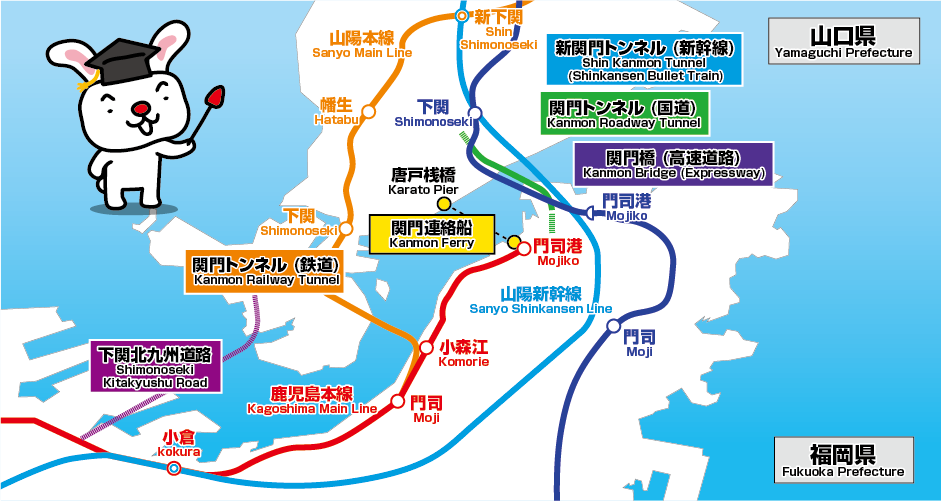
In 1889, Moji Port was designated as a special export port by the government to handle five commodities: coal, sulfur, rice, wheat, and flour, and it rapidly developed as a trading port on the continental route with a succession of branches of financial institutions, shipping companies, and trading companies. At this time, the Kanmon Tunnel and the Kanmon Bridge crossing the Kanmon Straits had not yet been constructed, and many Kanmon ferry boats were in operation, so Moji Port also served as the gateway to Kyushu. However, it gradually lost its status as a trading port due to the opening of the Kanmon Railway Tunnel in 1942, which made it possible to exchange logistics with Honshu without going through Mojiko Station, and the cessation of continental trade after the war (1945).
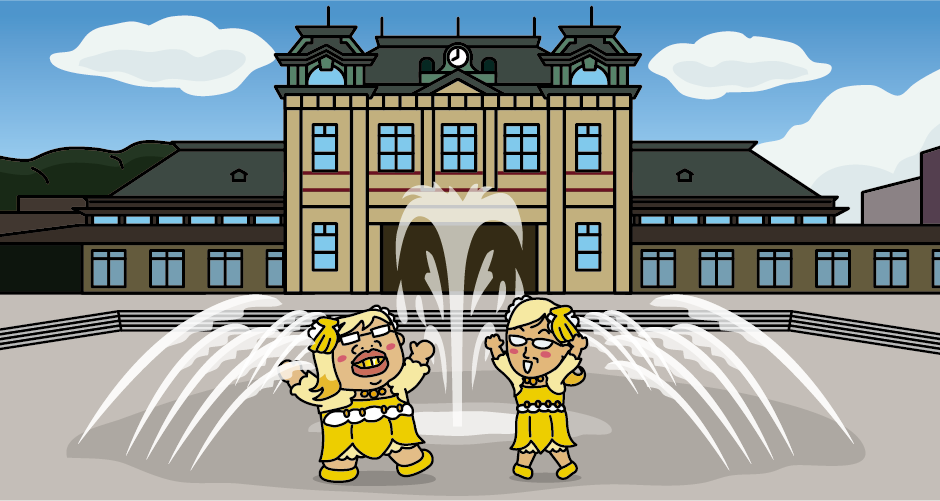
In 1988, the Mojiko Station building was designated as a National Important Cultural Property, and the area around old Moji Port was developed as the Mojiko Retro district, utilizing historical buildings from the late 19th and early 20th centuries, and now attracts more than 2 million tourists annually.
Major historical buildings in the Mojiko Retro District include Mojiko Station building, Kyushu Railway History Museum, former O.S.K.Line building, former Moji Mitsui Club, former Moji Customs House, and Moji Telecommunication Museum. (Details are explained in the “Mojiko Retro” section.)
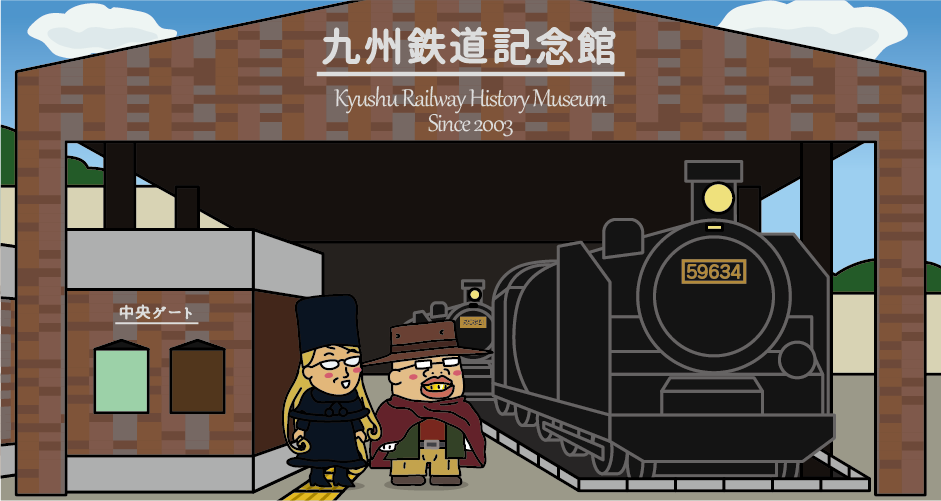
The Kyushu Railway History Museum (2 minute-walk from JR Mojiko Station) is a railroad museum housed in the headquarters building of the Kyushu Railway Company, the first company established in Kyushu in 1891. Inside the museum, the history of Kyushu’s railroads is introduced through photographs and models from that time. Outside, nostalgic actual vehicles such as steam locomotives and limited express trains are on display, some of which visitors can actually ride on. There is also a miniature railroad park where children can drive trains with equipment similar to that of an actual railroad. Details are explained in the “Kyushu Railway History Museum” section.
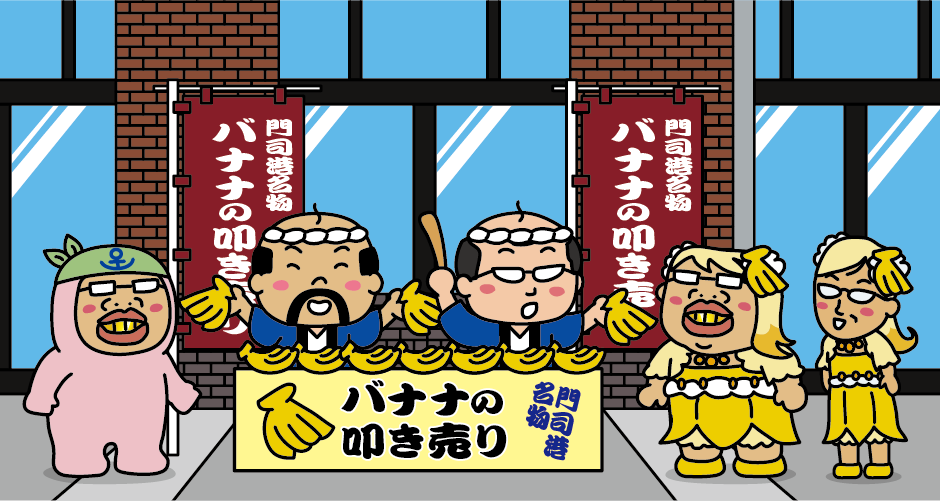
Mojiko is the birthplace of the “Banana no Tatakiuri (Banana Auction).” Banana no Tatakiuri is a method of selling bananas at auction that is said to have developed in Mojiko. The seller uses witty speeches to attract customers, and then gradually lowers the price starting with the highest price. The seller is accompanied by an assistant who receives payment and hands the bananas wrapped in newspaper to the buyer.
The first commercial import of bananas to Japan was in 1903. Kinjiro Toshima of the Keelung branch of Osaka Shosen Kaisha (OSK) brought seven baskets (about 420 kg) of bananas from Taiwan to Kobe. Osaka Shosen Kaisha
Incidentally, until bananas were imported in cardboard boxes, they were transported in bamboo baskets; until the early 20th century, the trade was mainly 60 kg per basket.
Later, as banana imports increased, bananas were unloaded at Moji Port, partly due to its geographical proximity to Taiwan. Since ripe yellow bananas may be infested with insect pests, importation of yellow bananas is prohibited in order to prevent pest infestation. Therefore, all bananas freshly unloaded in Japan are green unripe bananas, and they are placed in a humid room to ripen to a yellow color before being released into the market. However, they are steamed or damaged during transportation, and as a means to obtain cash as quickly as possible, bananas are sold at street stalls, which is how the “Banana no Tatakiuri” method began.
A monument stands in front of JR Mojiko Station (on the side of the former Mojiko Mitsui Club), commemorating the birthplace of Banana no Tatakiuri. And at the Mojiko Retro Sightseeing Products Museum Minato House (6 minute-walk from JR Mojiko Station), Banana no Tatakiuri demonstrations are held every Saturday and Sunday from 1 pm. (The demonstration may be canceled, so please check the schedule.)
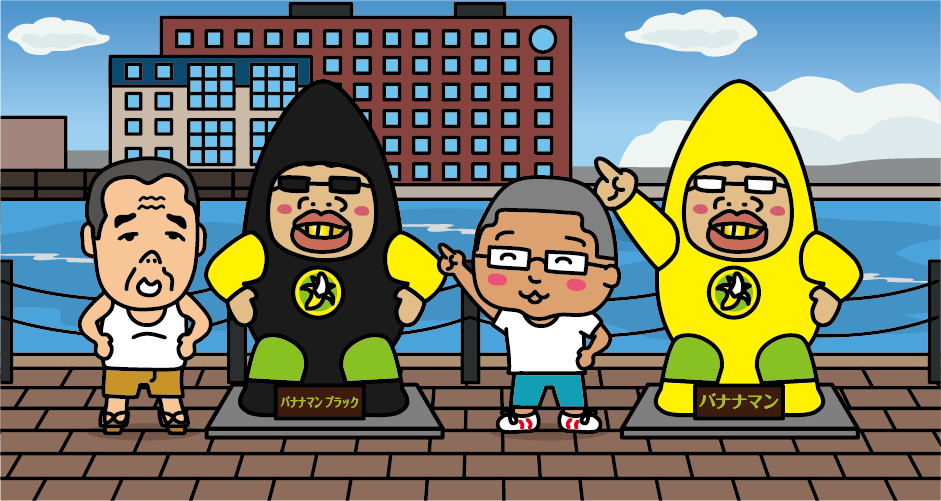
In front of Kaikyo Plaza (5 minute-walk from JR Mojiko Station), stand statues of Bananaman and Bananaman Black, the image characters of “Banana no Tatakiuri (Banana Auctions.)” The statues have unique poses and very realistic faces, making them a popular spot for commemorative photos. Kaikyo Plaza is a commercial complex lined with restaurants where you can enjoy local gourmet food, as well as cafes, general stores, seafood stores, souvenir shops, and more.
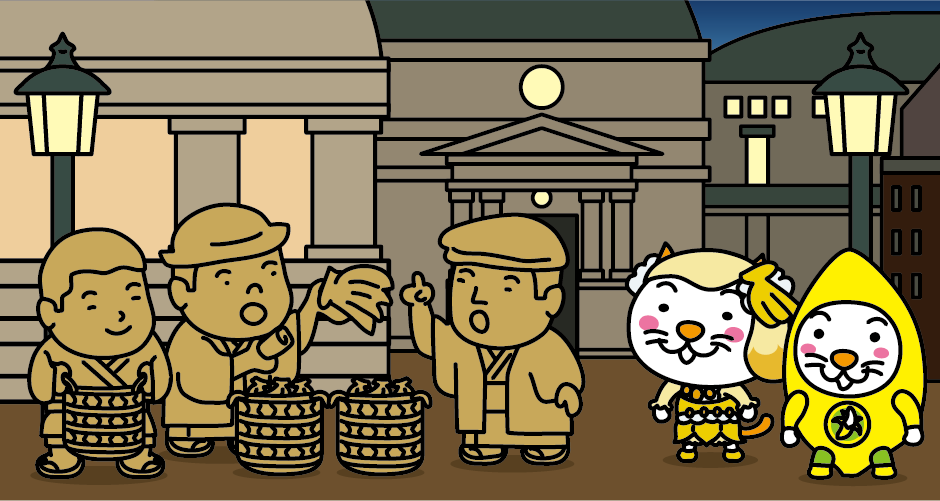
The Kanmon Strait Museum (8 minute-walk from JR Mojiko Station) is an interactive museum that introduces the history, culture, and nature of the Kanmon Straits through various productions. The museum features the “Strait Atrium,” where visitors can enjoy an experience linked to video images on one of the largest screens in Japan; the “Kanmon Historical Corridor,” which uses puppet art to recreate historical scenes set in the Kanmon Straits; the “Strait Experience Zone,” where visitors can experience ship-handling simulations; and the “Kaikyo Retro Street,” which recreates a street scene of Mojiko Port in the Taisho Period (1912-1926). The “Mojiko Banana Museum,” which is related to the “banana no Tatakiuri (Banana Auction)” that originated in Mojiko, is also located here. Details are explained in the “Kanmon Strait Museum” section.
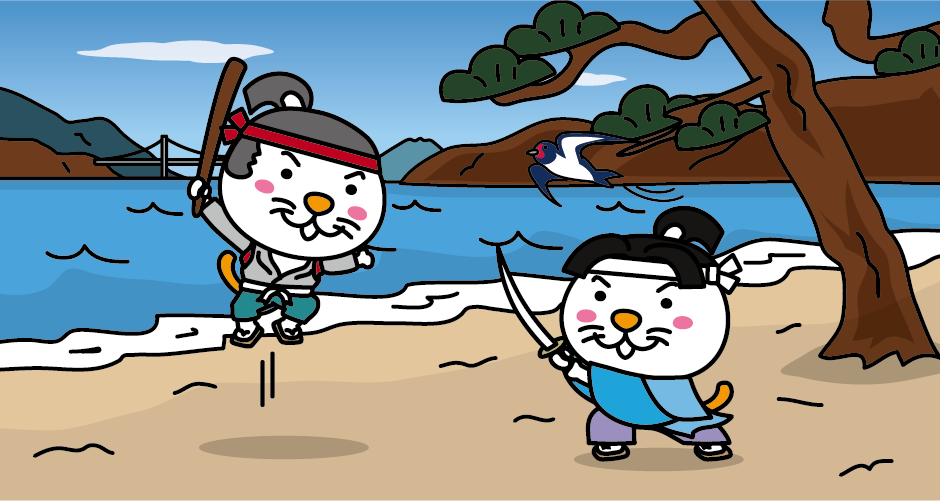
Ganryujima (Funashima) Island is located in the Kanmon Straits and is famous as the site of a duel between Miyamoto Musashi, the master of the two sword styles, and Sasaki Kojiro, the master of the secret sword methods, called Tsubamegaeshi. Boats to Ganryujima Island depart from either Karato Pier on the Shimonoseki side or Mojiko Pier near Mojiko Station. The boat ride takes about 10 minutes one way. The Mojiko Ganryujima Passage is currently not available on weekdays, and is only available on weekends and holidays. The history of Ganryujima Island is introduced in the ship’s announcements. Even taking into account the time it takes to get to the next boat, about one hour is sufficient for sightseeing at Ganryujima Island.
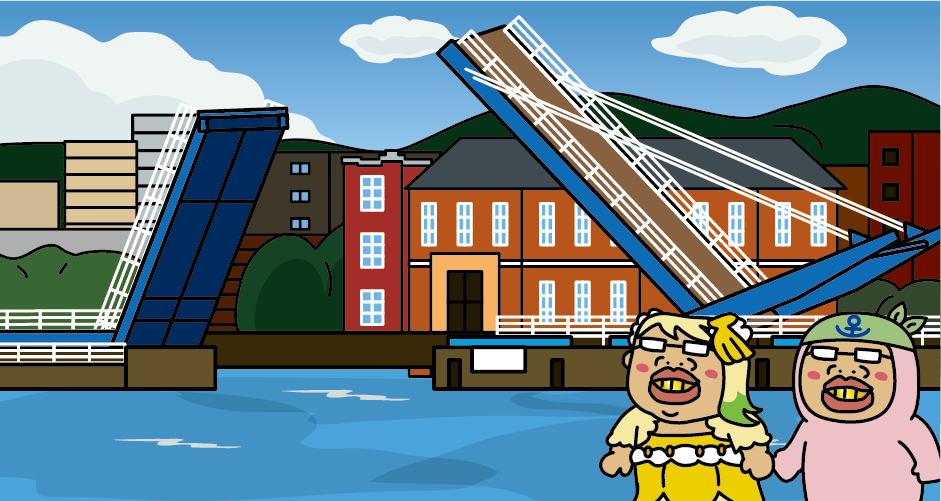
“Blue Wing Moji” (5 minute-walk from JR Mojiko Station) is a blue drawbridge that spans the Funadamari (berth) in old Moji Port. It is one of the largest pedestrian-only drawbridges in Japan, with a total length of 108 meters, and it bounces up to a 60-degree angle with the water surface a total of six times between 10:00 and 16:00 every day. It takes 4 minutes for the drawbridge to open, 20 minutes for it to stay open, and 8 minutes for it to close. The Blue Wing Moji has been selected as a sacred place for lovers, and it is said that the first couple to cross the drawbridge hand in hand when it closes will be united for life. Also, at night, it is recommended to walk on the bridge with your feet illuminated while enjoying the view of the lit-up retro port town.
Starting time for the bridge to bounce: 10:00, 11:00, 13:00, 14:00, 15:00, 16:00 / Ending time: 10:20, 11:20, 13:20, 14:20, 15:20, 16:20
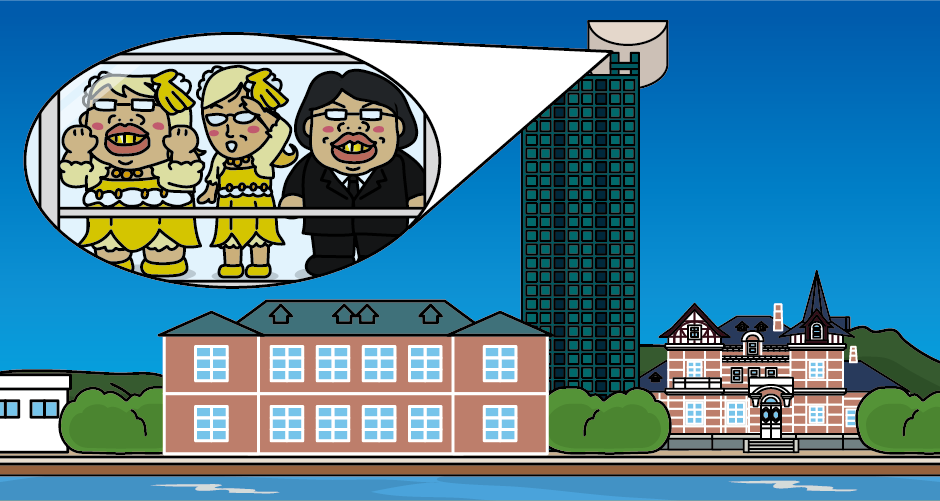
Mojiko Retro Observation Room (8 minute-walk from JR Mojiko Station) is located on the top 31st floor of Mojiko Retro Hi-Mart, a high-rise apartment building designed by Kisho Kurokawa, a leading Japanese architect. From a height of 103 meters, the view of the Kanmon Straits and Mojiko Retro townscape is spectacular. The night view is very popular as a date spot for lovers. Business hours: 10:00-22:00 (last admission at 21:30)
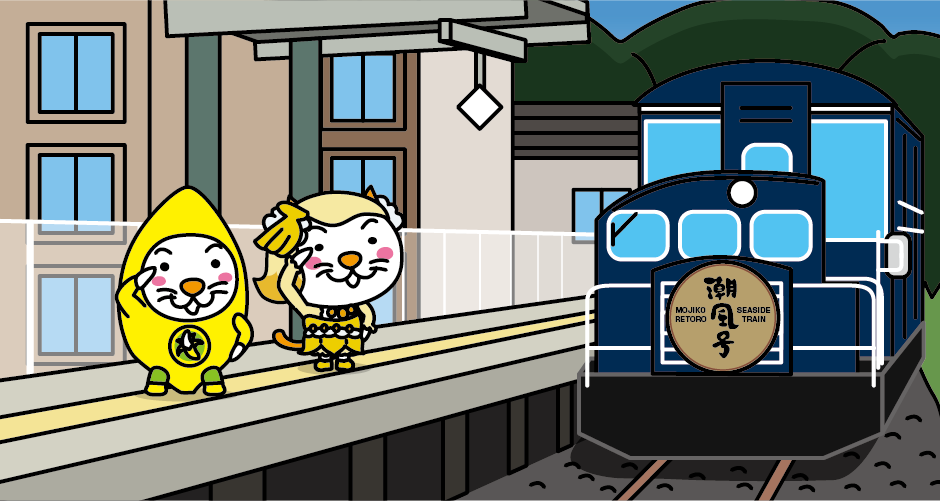
The Mojiko Retro Kanko Line of the Heisei Chikuho Railway is a sightseeing trolley train that runs from the Kyushu Railway History Museum adjacent to JR Mojiko Station, through the downtown Mojiko Retro District, under Kanmon Bridge, and to Mekari Park. It is nicknamed “Shiokaze-go.” It is recommended for those who wish to visit Mekari Shrine, walk inside the Kanmon Tunnel, or see the Kanmon Bridge up close. The total length of the line is 2.1 km, there are four stations: Kyushu Tetsudo Kinenkan Station, Idemitsu Bijutsukan Station, Norfolk Hiroba Station, and Kanmonkaikyo Mekari Station. Regular service runs on Saturdays, Sundays, and holidays (all year round, excluding year-end and New Year holidays), and during the spring and summer vacation seasons. Between Kyushu Tetsudo Kinenkan Station and Kanmonkaikyo Mekari Station, the train takes 10 minutes to board and 10 minutes to wait for a turnaround, making 11 round trips per day at 40-minute intervals from 10 to 17. On some days, the train operates at night until 21 (6 round trips).
Under the naming rights system, the Mojiko Retro Kanko Line is nicknamed the Kitakyushu Bank Retro Train.
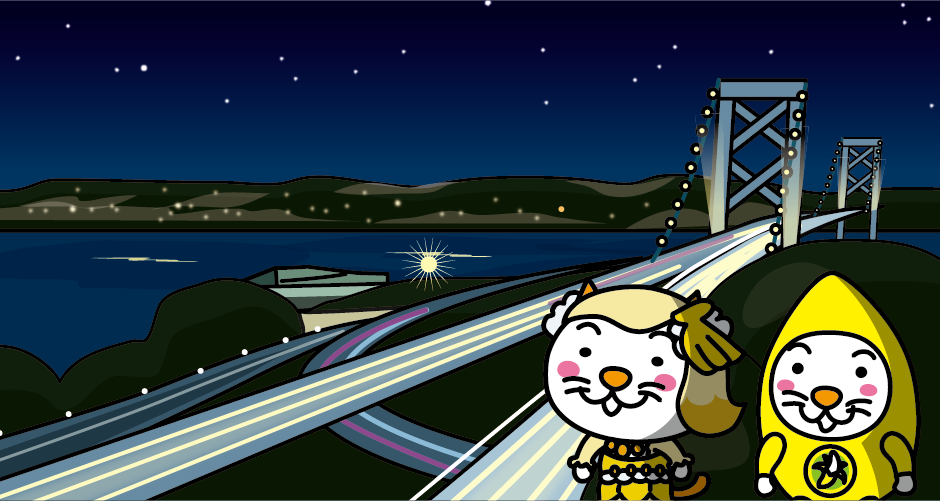
Mekari Park is located at the northernmost tip of Kyushu and the western edge of Setonaikai National Park, it is an urban park developed in the area of Mt. Kojo, where the ruins of Moji Castle are located. The total area of the park is 37.1 ha. The vast park includes a waterfront area where visitors can enjoy a close-up view of the Kanmon Straits, Kanmon Bridge, and passing ships. And the No.2 Observation Deck, from which you can see the entire Kanmon Straits and Kanmon Bridge, offers a panoramic view from Mojiko to Shimonoseki. It’s not only popular during the day, but the night view of the illuminated Kanmon Bridge and city lights is gaining popularity. Details are explained in the “Mekari Park” section. Access to No.2 Observation Deck is a 15-minute walk from Norfolk Hiroba Station on the Mojiko Retro Kanko Line, or Nishitetsu Bus (bound for Mekari) from JR Mojiko Station to Mekari Koen-mae Bus Stop. 15 minute-walk.
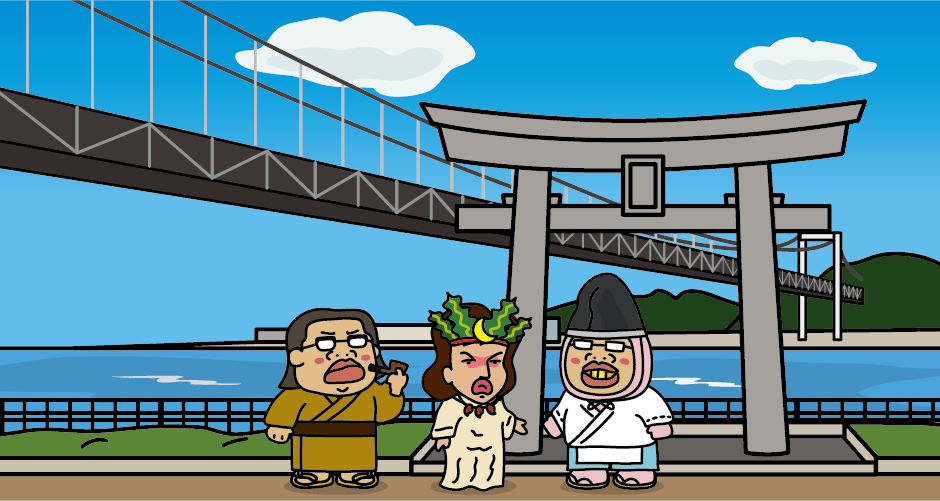
Mekari Shrine is located at the western end of Mekari Park. It is said that it was founded by Empress Jingu in 200 AD after her Sankan Seibatsu (conquest of the Three Korean Kingdoms). It is famous for the “Mekari Shinto ritual,” which is held every year before dawn on New Year’s Day according to the lunar calendar. Details are explained in the “Mekari Shrine” section. Access to Mekari Shrine is 8 minut-walk from Kanmon Kaikyo Mekari Station on the Mojiko Retro Kanko Line, or Nishitetsu Bus (bound for Mekari) from JR Mojiko Station to Mekari Jinja-mae Bus Stop, a short walk.
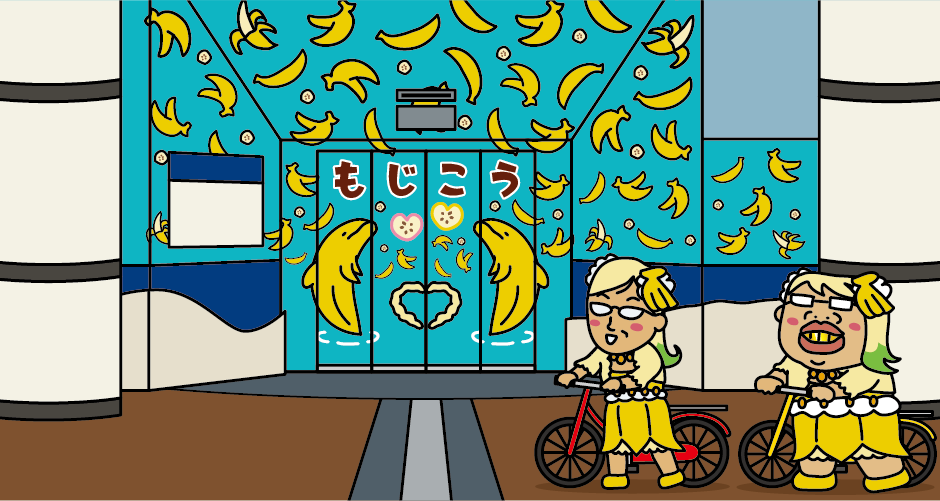
Adjacent to the Mekari Shrine is the entrance to the Kanmon Pedestrian Tunnel (Moji side). The Kanmon Pedestrian Tunnel is a sightseeing spot where you can walk across the bottom of the Kanmon Straits, and in about 15 minutes you will reach “Mimosusogawa Park” (the site of the ancient battlefield of Dannoura), one of Shimonoseki’s most popular tourist attractions. Details are explained in the “Kanmon Tunnel” section.

“Yaki Curry” is a local delicacy representative of the Mojiko Retro District. It was first introduced as a menu item after a Japanese restaurant on Sakae-machi Ginten-gai Shopping Arcade in the Showa 30s (1955-1964), when a Makanai dish of leftover curry baked in an oven in an earthenware pot in the style of doria was so popular. (Makanai dish is food that is prepared for the employees of a restaurant rather than being served to customers)
Yaki curry is rice topped with curry, cheese, and an egg and baked in the oven, but the taste, appearance, and ingredients vary from restaurant to restaurant. Some restaurants add toppings such as puffer fish, octopus, and other seafood, allowing customers to enjoy a wide variety of flavors at each restaurant.
Today, Yaki curry is served at a variety of restaurants, including specialty stores, cafes, and restaurants in the Mojiko Retro District.
Access to Mojiko
It takes about 1 hour 50 minutes from Haneda Airport (Tokyo) to Kitakyushu Airport. It takes about 35 minutes by Nishitetsu bus from Kitakyushu Airport to JR Kokura Station.
It takes about 2 hours 20 minutes by Shinkansen from JR Shin-Osaka Station to JR Kokura Station.
It takes about 15 minutes by Kagoshima Main Line (to Mojiko Station) from JR Kokura Station to JR Mojiko Station. Get off at JR Mojiko Station, a short walk.

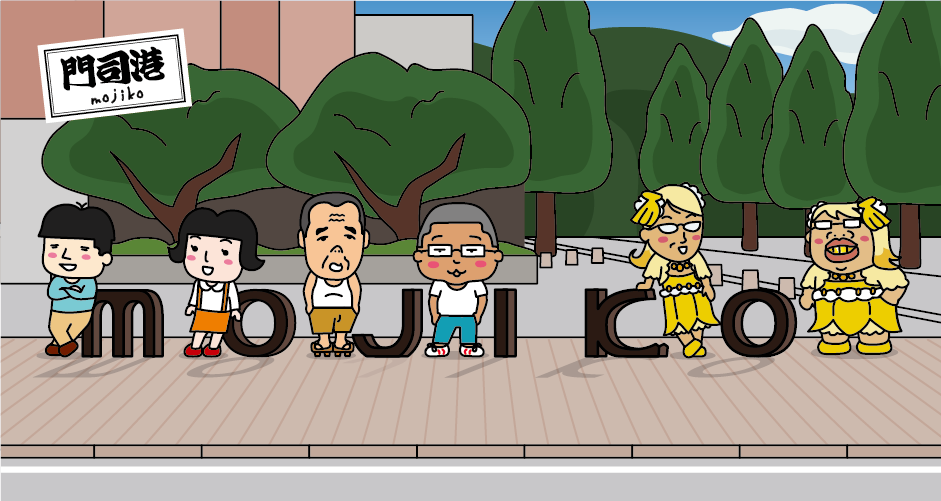


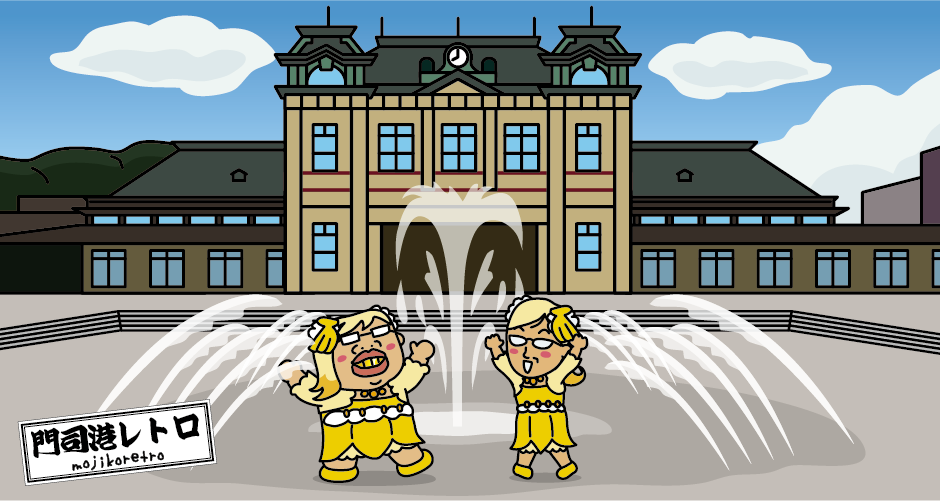

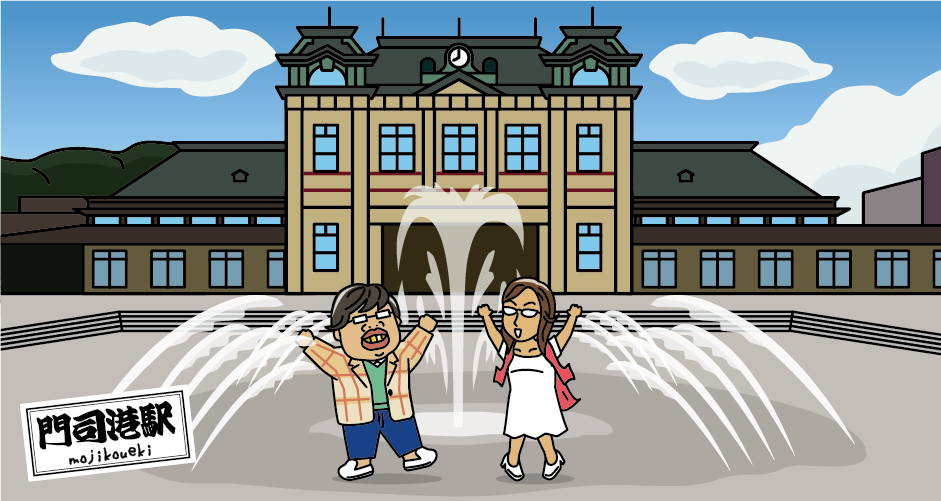
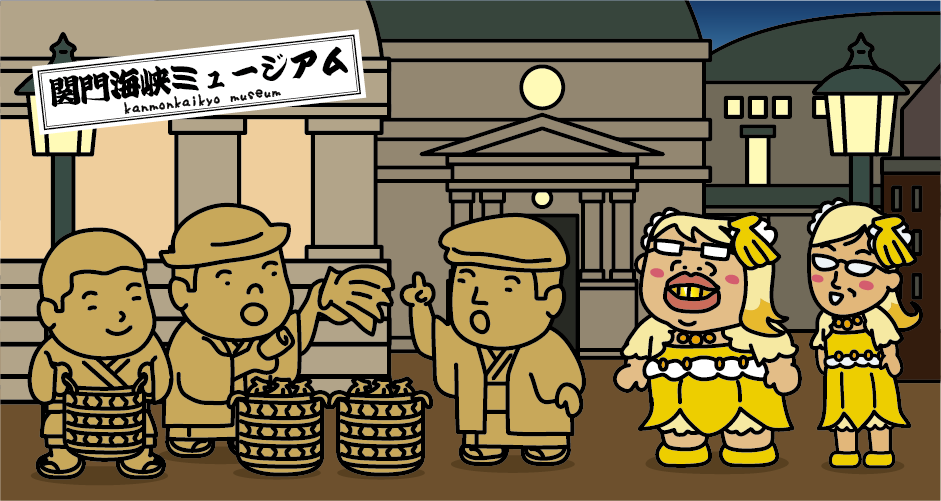
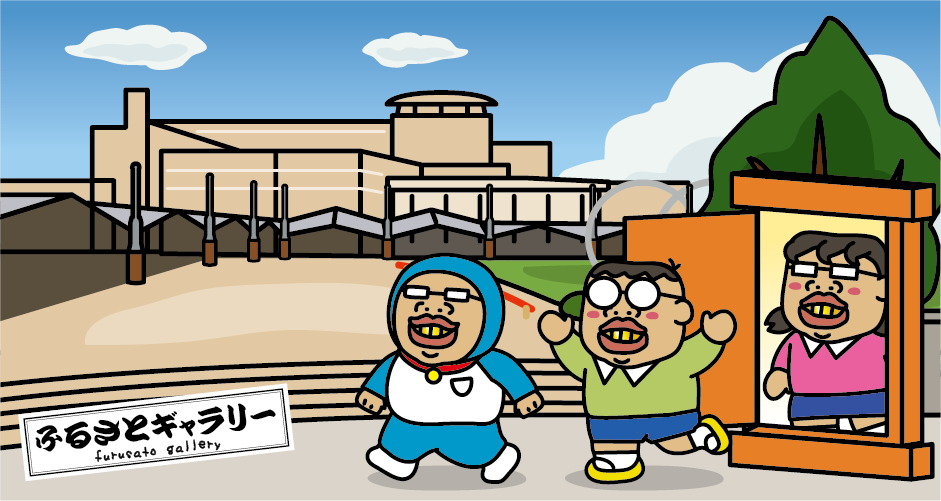
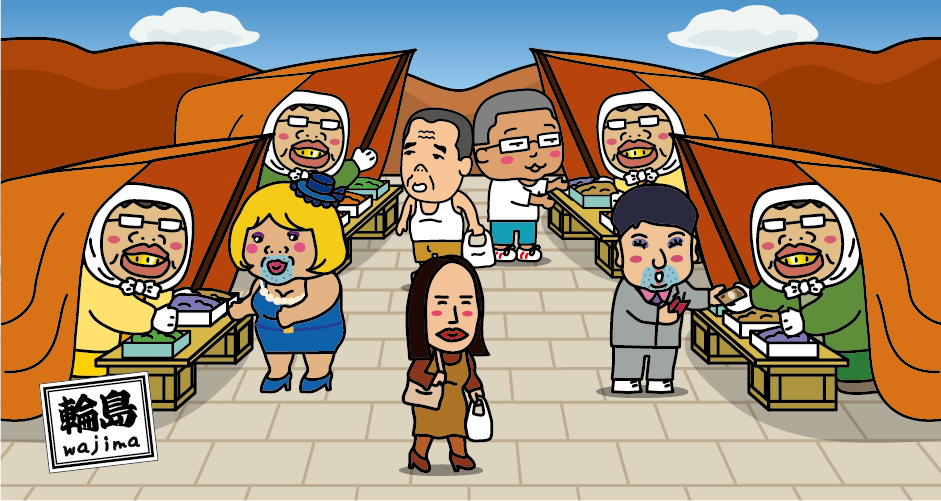
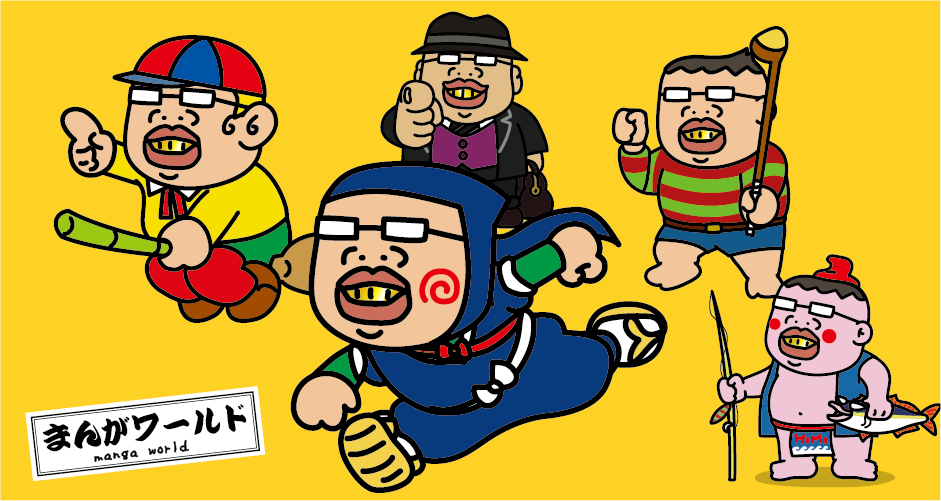
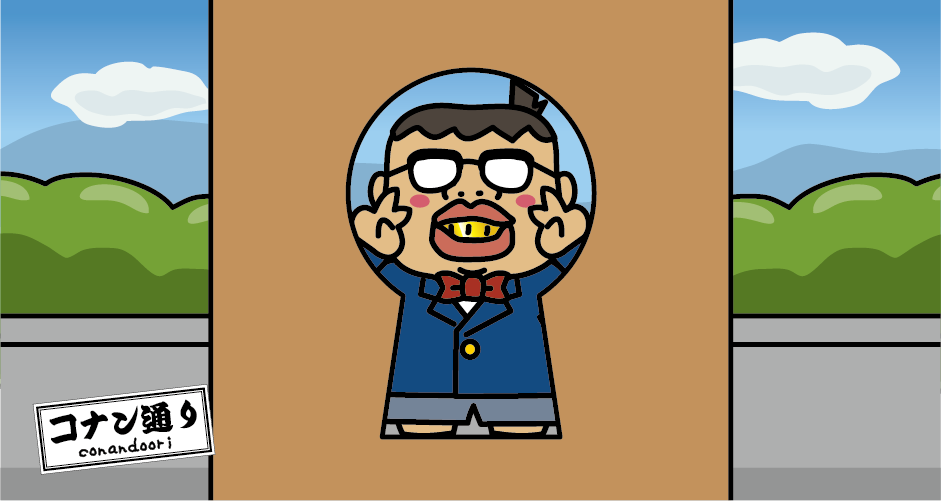
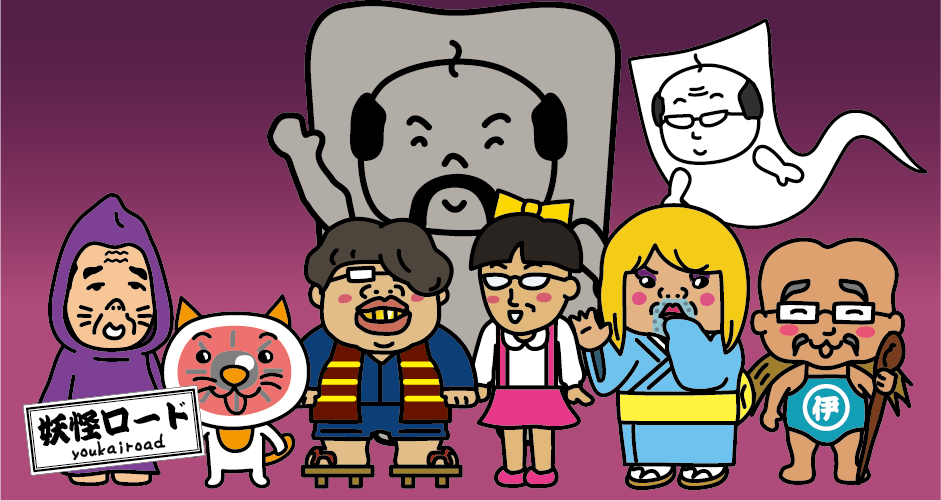

You need to login to comment on an article.